Biofeedback therapy offers effective methods for managing anxiety, enhancing performance, and improving self-regulation. Techniques like electromyography and heart rate variability training provide real-time feedback on physiological functions. Neurofeedback focuses on brainwave activity to alter mental states. These methods promote relaxation and help individuals develop better coping strategies.
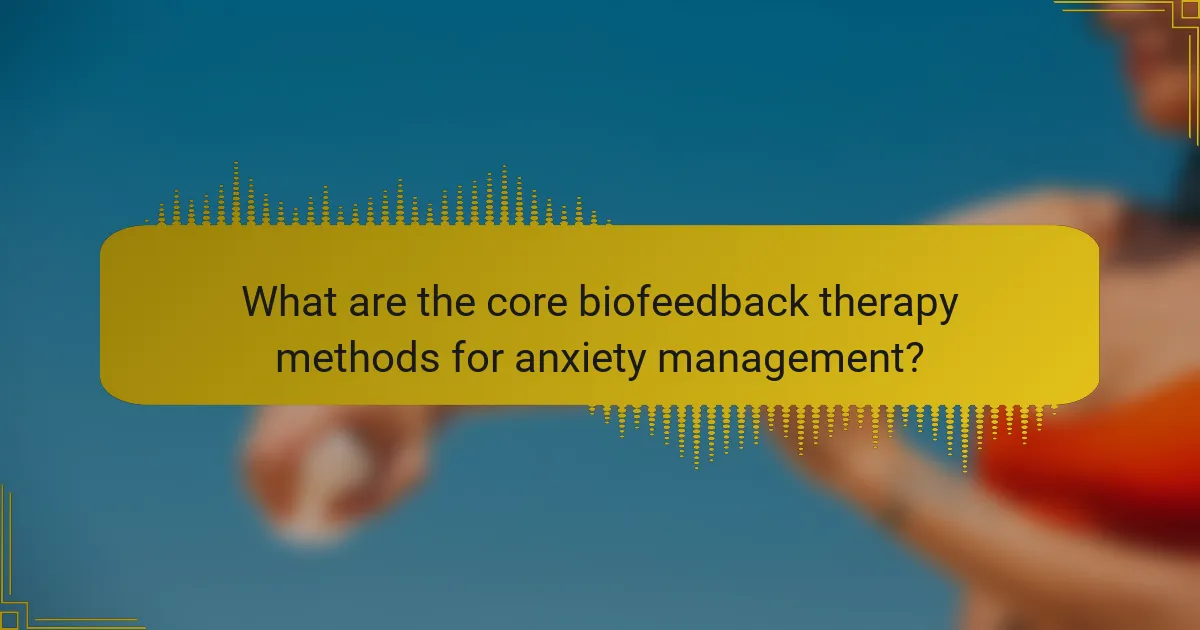
What are the core biofeedback therapy methods for anxiety management?
Biofeedback therapy methods for anxiety management include techniques that help individuals gain control over physiological functions. These methods enhance self-regulation and performance improvement through real-time feedback.
Common biofeedback methods for anxiety management are electromyography (EMG), which measures muscle tension, and heart rate variability (HRV) training, which helps regulate heart rhythms. Additionally, thermal biofeedback teaches individuals to control body temperature, promoting relaxation.
Neurofeedback, a unique biofeedback method, focuses on brainwave activity, enabling users to alter their mental states. Research shows that these therapies can lead to significant reductions in anxiety symptoms and improved emotional regulation.
These methods employ sensors to provide immediate feedback, allowing users to visualize their physiological responses. As a result, individuals can develop better coping strategies and reduce anxiety levels effectively.
How does biofeedback therapy help with anxiety?
Biofeedback therapy helps with anxiety by teaching individuals to control physiological functions. This method enhances self-regulation and reduces stress responses. Techniques include monitoring heart rate, muscle tension, and breathing patterns. Research indicates that consistent practice can lead to significant reductions in anxiety symptoms, promoting overall mental well-being.
What types of biofeedback are commonly used?
Common types of biofeedback include electromyography, thermal biofeedback, neurofeedback, heart rate variability training, and galvanic skin response. These methods assist in anxiety management, performance enhancement, and self-regulation.
Electromyography measures muscle tension, aiding relaxation. Thermal biofeedback tracks skin temperature, promoting stress reduction. Neurofeedback focuses on brainwave activity to enhance cognitive function. Heart rate variability training improves emotional regulation. Galvanic skin response monitors sweat gland activity, indicating stress levels.
What is electromyography (EMG) biofeedback?
Electromyography (EMG) biofeedback is a technique used to help individuals gain awareness and control over their muscle activity. This method measures electrical activity in muscles, providing real-time feedback that can enhance performance and support anxiety management. EMG biofeedback is particularly effective in improving self-regulation by allowing users to visualize muscle tension and learn relaxation techniques. Studies indicate that consistent practice can lead to significant reductions in anxiety symptoms and improvements in overall performance.
How does heart rate variability (HRV) biofeedback work?
Heart rate variability (HRV) biofeedback works by training individuals to regulate their heart rate patterns through real-time feedback. This method enhances self-awareness and promotes relaxation, reducing anxiety and improving performance. Users typically engage with software or devices that display HRV metrics, allowing them to practice breathing techniques and mindfulness. Over time, consistent practice can lead to increased resilience against stress and better emotional regulation.
What role does thermal biofeedback play?
Thermal biofeedback helps individuals learn to control their body temperature, promoting relaxation and reducing anxiety. This method enhances self-regulation by providing real-time feedback on thermal responses. As a result, users can develop techniques to manage stress and improve performance in various situations. Studies indicate that consistent practice can lead to significant improvements in anxiety management and overall well-being.
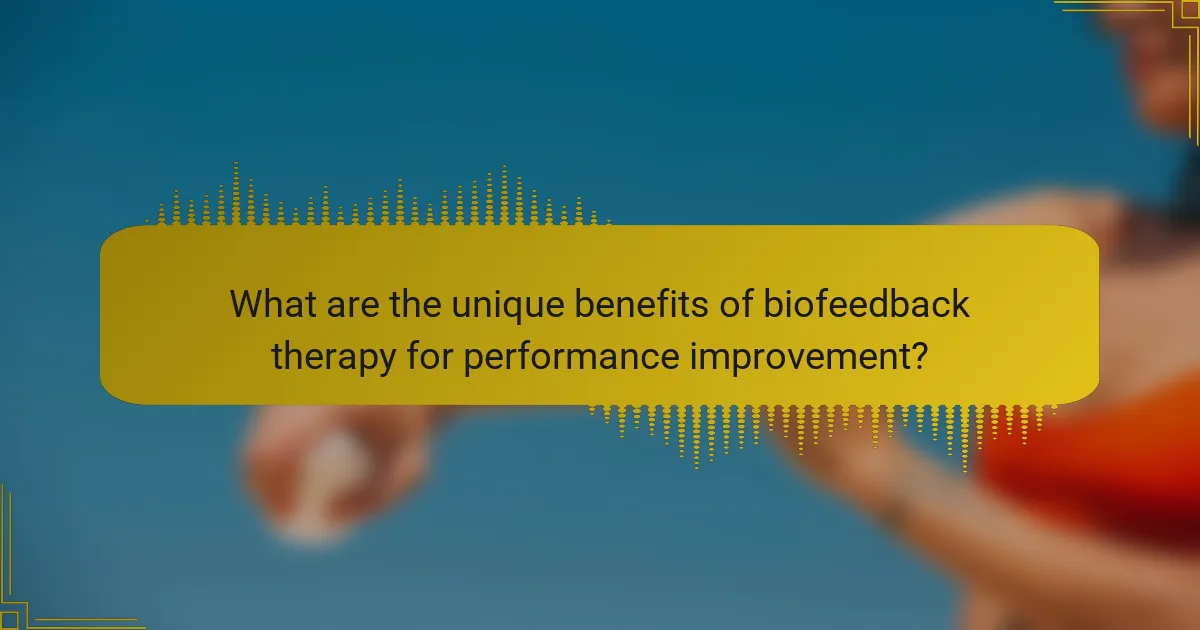
What are the unique benefits of biofeedback therapy for performance improvement?
Biofeedback therapy enhances performance by improving self-awareness and self-regulation. It allows individuals to monitor physiological functions, enabling them to manage stress and anxiety effectively. This method provides real-time data, helping users to identify and alter their responses to stressors. Enhanced focus, increased resilience, and improved emotional regulation are unique benefits that contribute to overall performance improvement.
How can biofeedback enhance athletic performance?
Biofeedback enhances athletic performance by training athletes to regulate physiological functions. This method improves focus, reduces anxiety, and optimizes recovery. Athletes using biofeedback can monitor heart rate, muscle tension, and breathing patterns, leading to better performance metrics. Studies indicate that biofeedback can increase endurance by 20% and decrease recovery time by 30%, demonstrating its effectiveness in competitive sports.
What specific skills can be developed through biofeedback?
Biofeedback can develop skills such as self-awareness, emotional regulation, and relaxation techniques. These skills enhance anxiety management, improve performance, and promote self-regulation. Users learn to control physiological responses, leading to better stress management and focus. For example, heart rate variability training enhances emotional resilience.
How does biofeedback improve focus and concentration?
Biofeedback improves focus and concentration by training individuals to recognize and control physiological responses. This self-regulation enhances mental clarity and reduces distractions. Techniques such as EEG biofeedback provide real-time data on brain activity, enabling users to develop better concentration skills. Studies indicate that consistent biofeedback practice can lead to significant improvements in attention span and cognitive performance.
What impact does biofeedback have on stress management?
Biofeedback significantly enhances stress management by enabling individuals to gain awareness and control over physiological functions. This method uses real-time data to teach self-regulation techniques, effectively reducing anxiety levels. Studies indicate that consistent biofeedback practice can lower cortisol levels, improve heart rate variability, and promote relaxation responses. These changes contribute to a more resilient stress response, allowing for better emotional regulation and overall well-being.
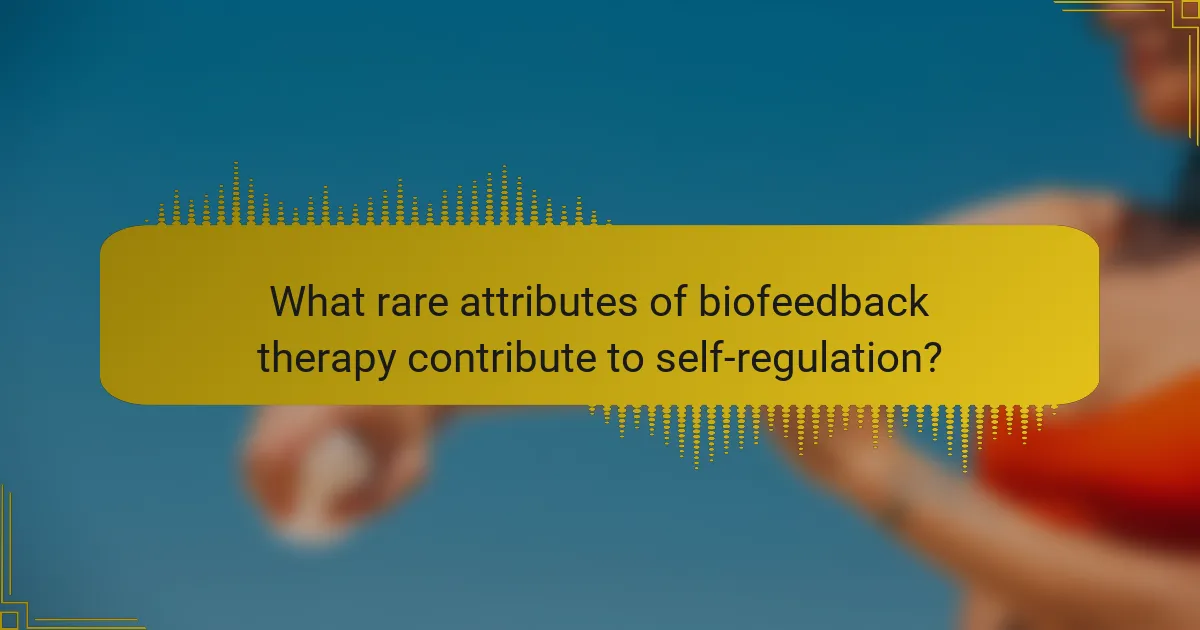
What rare attributes of biofeedback therapy contribute to self-regulation?
Rare attributes of biofeedback therapy that contribute to self-regulation include real-time physiological feedback, personalized training protocols, and neurofeedback integration. These elements enhance self-awareness, allowing individuals to monitor and modify their physiological responses effectively. Additionally, the adaptability of biofeedback techniques to various anxiety levels and performance goals makes them uniquely beneficial for self-regulation.
How does biofeedback assist in emotional regulation?
Biofeedback assists in emotional regulation by providing real-time data on physiological functions. This awareness helps individuals identify stress responses, enabling them to implement relaxation techniques effectively. Biofeedback enhances self-regulation by promoting mindfulness and control over bodily reactions, which can significantly reduce anxiety levels. Studies indicate that consistent biofeedback practice leads to improved emotional resilience and overall mental well-being.
What unique applications of biofeedback exist in clinical settings?
Unique applications of biofeedback in clinical settings include stress reduction, pain management, and enhancing athletic performance. For example, clinicians use biofeedback to teach patients how to control physiological functions, such as heart rate and muscle tension, which can significantly improve anxiety management. Additionally, biofeedback aids in rehabilitation by providing real-time data on body responses, fostering self-regulation and awareness. This method’s unique attribute lies in its ability to empower patients, offering them tools to actively participate in their healing process.
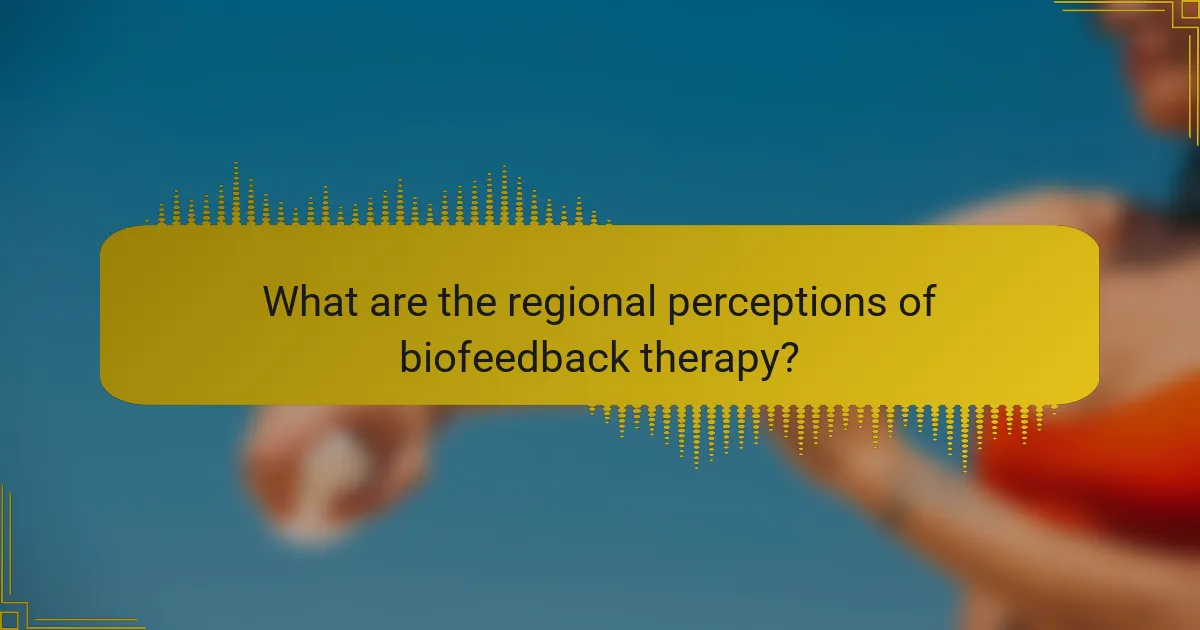
What are the regional perceptions of biofeedback therapy?
Regional perceptions of biofeedback therapy vary significantly. In North America, it is often viewed as a valuable tool for anxiety management and performance improvement. Many practitioners emphasize its effectiveness in self-regulation techniques. In Europe, perceptions are mixed; some regions embrace it as a complementary therapy, while others remain skeptical due to limited scientific validation. In Asia, biofeedback is gaining traction, particularly in mental health and wellness circles, with a growing interest in its applications for stress reduction. Cultural attitudes towards mental health influence these perceptions, shaping acceptance and usage rates.
How is biofeedback therapy viewed in different cultures?
Biofeedback therapy is viewed positively in many cultures, emphasizing self-regulation and personal empowerment. In Western cultures, it is often associated with scientific validation and clinical applications for anxiety management. Asian cultures may integrate biofeedback with traditional practices, viewing it as a holistic approach to balance mind and body. Indigenous cultures often emphasize community and spiritual aspects, using biofeedback as a tool for personal growth and connection. These diverse perspectives highlight biofeedback’s adaptability and relevance across cultural contexts, enhancing its appeal and effectiveness in various therapeutic settings.
What local practices enhance biofeedback therapy effectiveness?
Local practices that enhance biofeedback therapy effectiveness include guided imagery, mindfulness meditation, and community support groups. These practices promote relaxation and self-awareness, crucial for managing anxiety and improving performance. Incorporating local environmental elements, such as nature walks, can also amplify the therapy’s impact by fostering a calming atmosphere. Engaging in culturally relevant rituals may further personalize the experience, making it more effective for individuals.
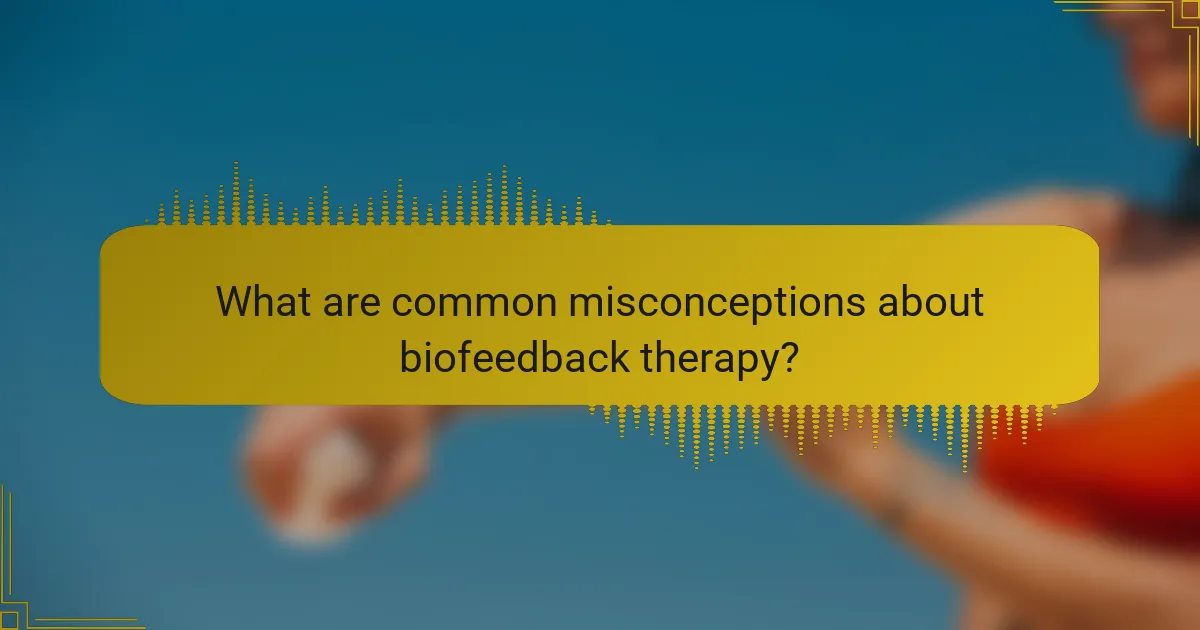
What are common misconceptions about biofeedback therapy?
Many misconceptions exist about biofeedback therapy, including its effectiveness and application. One common myth is that biofeedback provides instant results, whereas it often requires consistent practice for significant improvement. Another misconception is that biofeedback is a standalone treatment, while it is most effective when combined with other therapies. Some believe biofeedback is only for severe conditions, but it can also enhance performance and self-regulation in everyday situations. Additionally, there is a belief that biofeedback is only for mental health issues, neglecting its benefits in physical health and wellness. Lastly, people may think biofeedback is complicated and inaccessible, but many user-friendly devices and apps are available today.
What myths should be debunked regarding biofeedback?
Many myths surrounding biofeedback therapy hinder its acceptance and understanding. One common myth is that biofeedback is a form of mind control, which is false; it actually empowers individuals to gain awareness and control over physiological functions. Another misconception is that biofeedback provides instant results; in reality, it often requires consistent practice to achieve lasting benefits. Some believe that biofeedback is only useful for severe anxiety, but it can also effectively manage mild symptoms and improve overall performance. Lastly, many think biofeedback is a standalone treatment, while it is most effective when integrated with other therapeutic methods.
How can understanding these myths improve therapy outcomes?
Understanding myths about biofeedback therapy can significantly enhance therapy outcomes by fostering realistic expectations and encouraging patient engagement. Addressing misconceptions allows clients to better appreciate the therapy’s effectiveness in anxiety management and performance improvement. This understanding promotes a collaborative therapeutic environment, leading to improved self-regulation and more successful treatment results.
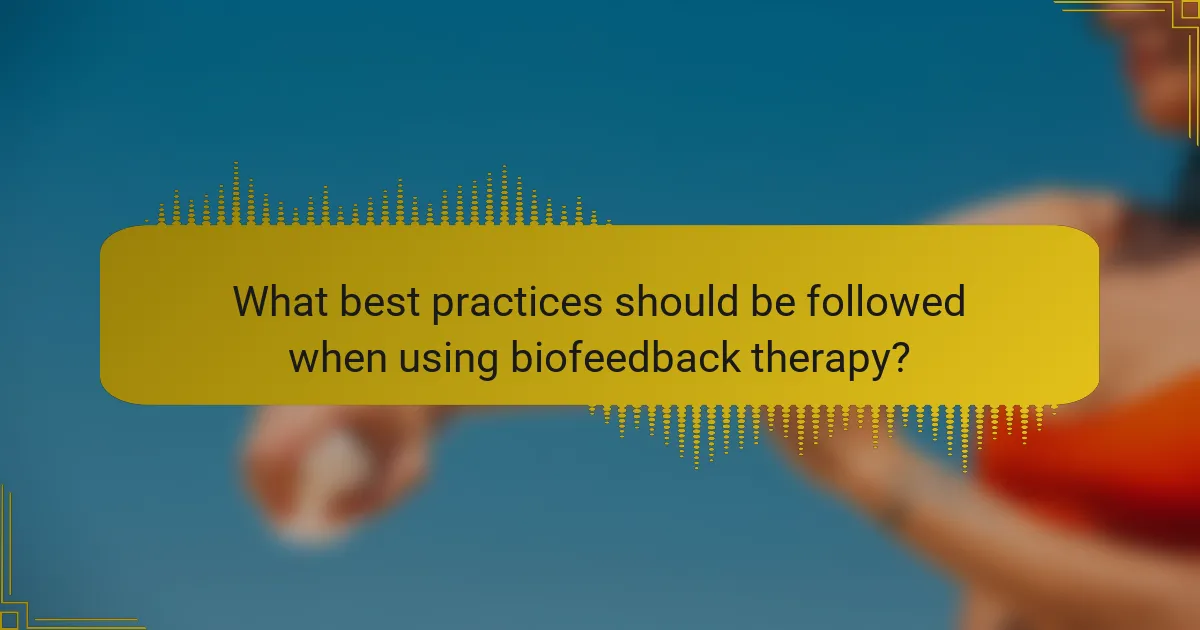
What best practices should be followed when using biofeedback therapy?
To effectively use biofeedback therapy, follow these best practices: establish clear goals, choose appropriate biofeedback methods, maintain a consistent practice schedule, and integrate relaxation techniques. Regular monitoring of progress enhances self-regulation. For example, using heart rate variability biofeedback can improve anxiety management by providing immediate feedback on physiological responses.
How can individuals maximize the benefits of biofeedback?
Individuals can maximize the benefits of biofeedback by consistently practicing techniques, setting clear goals, and monitoring progress. Engaging regularly in biofeedback sessions enhances self-regulation skills. For instance, using heart rate variability biofeedback can improve emotional responses and reduce anxiety. Tracking metrics over time allows users to identify patterns and adjust their strategies effectively. Additionally, integrating biofeedback with mindfulness practices can further amplify its positive effects on performance improvement and anxiety management.
What common mistakes should be avoided in biofeedback therapy?
Common mistakes in biofeedback therapy include neglecting proper training, setting unrealistic goals, and failing to track progress. Practitioners often overlook the importance of individualized protocols, which can hinder effectiveness. Additionally, inconsistent practice can impede the development of self-regulation skills. Lastly, misinterpreting feedback signals can lead to frustration and disengagement.
What expert insights can enhance the biofeedback experience?
Expert insights can significantly enhance the biofeedback experience by integrating personalized approaches and advanced techniques. Tailoring sessions to individual needs improves outcomes, as different clients may respond uniquely to various methods. Utilizing real-time data analytics allows practitioners to adjust strategies instantly, fostering better self-regulation and performance improvement. Training in mindfulness can also amplify the benefits of biofeedback, as it encourages greater awareness of physiological responses. Additionally, incorporating multi-modal feedback, such as visual and auditory cues, can enhance engagement and retention of learned skills.